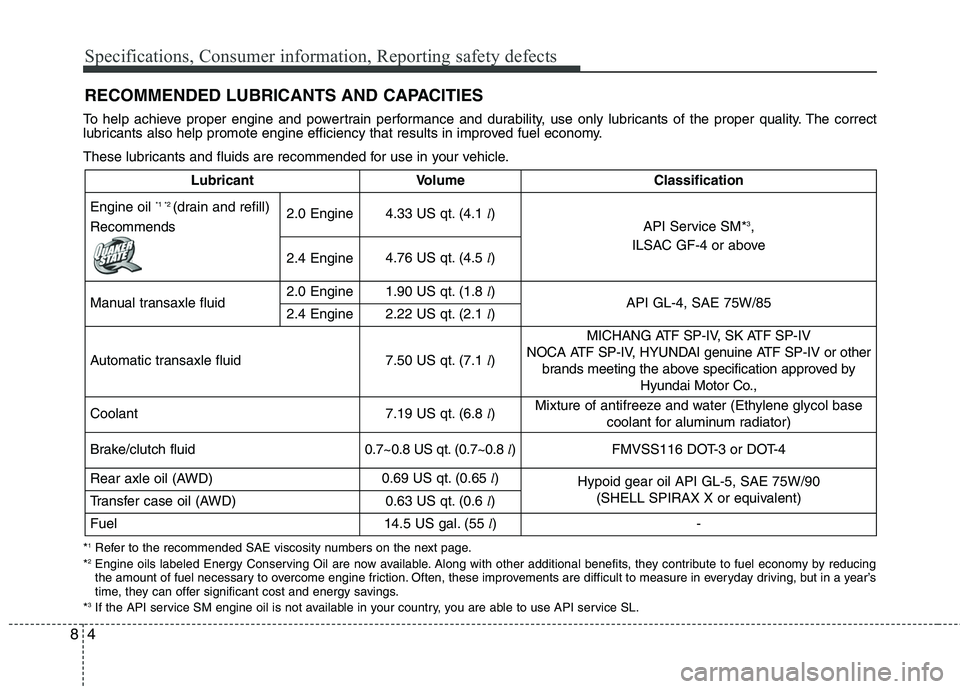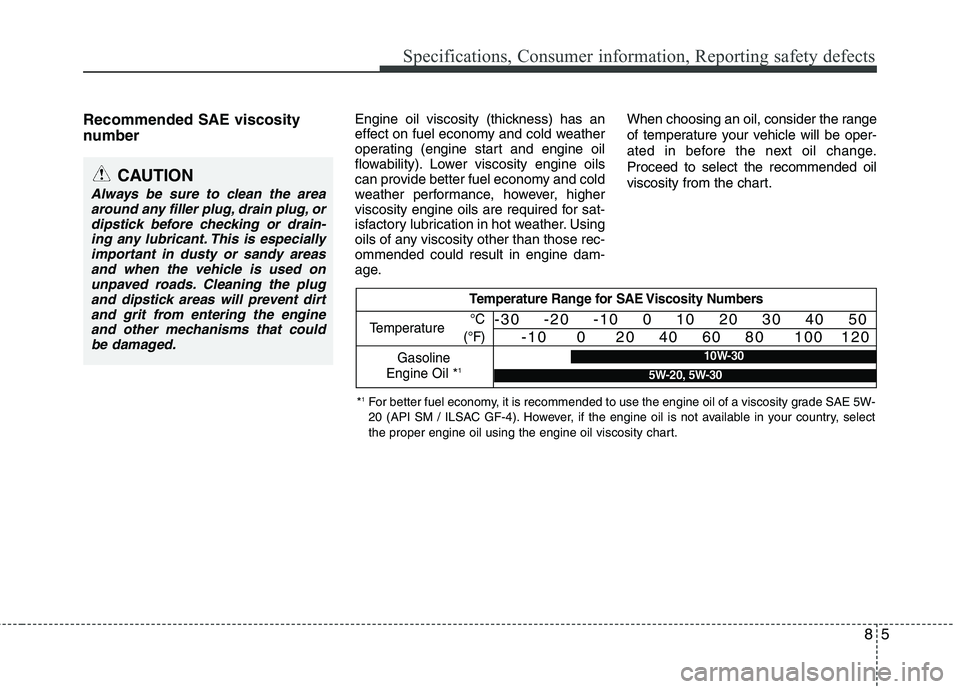Page 367 of 382

Specifications, Consumer information, Reporting safety defects
4
8
RECOMMENDED LUBRICANTS AND CAPACITIES
To help achieve proper engine and powertrain performance and durability, use only lubricants of the proper quality. The correct
lubricants also help promote engine efficiency that results in improved fuel economy.
These lubricants and fluids are recommended for use in your vehicle.
*1Refer to the recommended SAE viscosity numbers on the next page.
*2Engine oils labeled Energy Conserving Oil are now available. Along with other additional benefits, they contribute to fuel econo my by reducing
the amount of fuel necessary to overcome engine friction. Often, these improvements are difficult to measure in everyday driving , but in a year’s
time, they can offer significant cost and energy savings.
*
3If the API service SM engine oil is not available in your country, you are able to use API service SL.
LubricantVolumeClassification
Engine oil *1 *2 (drain and refill)
Recommends2.0 Engine4.33 US qt. (4.1 l)API Service SM*3,
ILSAC GF-4 or above
2.4 Engine4.76 US qt. (4.5 l)
Manual transaxle fluid2.0 Engine1.90 US qt. (1.8 l)API GL-4, SAE 75W/852.4 Engine2.22 US qt. (2.1 l)
Automatic transaxle fluid7.50 US qt. (7.1 l)
MICHANG ATF SP-IV, SK ATF SP-IV
NOCA ATF SP-IV, HYUNDAI genuine ATF SP-IV or other brands meeting the above specification approved by Hyundai Motor Co.,
Coolant 7.19 US qt. (6.8 l)Mixture of antifreeze and water (Ethylene glycol base
coolant for aluminum radiator)
Brake/clutch fluid0.7~0.8 US qt. (0.7~0.8 l)FMVSS116 DOT-3 or DOT-4
Rear axle oil (AWD)0.69 US qt. (0.65 l)Hypoid gear oil API GL-5, SAE 75W/90
(SHELL SPIRAX X or equivalent)
Transfer case oil (AWD)0.63 US qt. (0.6 l)
Fuel14.5 US gal. (55 l)-
Page 368 of 382

85
Specifications, Consumer information, Reporting safety defects
Recommended SAE viscosity
number Engine oil viscosity (thickness) has an
effect on fuel economy and cold weather
operating (engine start and engine oil
flowability). Lower viscosity engine oils
can provide better fuel economy and cold
weather performance, however, higher
viscosity engine oils are required for sat-
isfactory lubrication in hot weather. Using
oils of any viscosity other than those rec-
ommended could result in engine dam-
age.When choosing an oil, consider the range
of temperature your vehicle will be oper-
ated in before the next oil change.
Proceed to select the recommended oil
viscosity from the chart.
CAUTION
Always be sure to clean the area
around any filler plug, drain plug, ordipstick before checking or drain-ing any lubricant. This is especiallyimportant in dusty or sandy areasand when the vehicle is used on unpaved roads. Cleaning the plugand dipstick areas will prevent dirtand grit from entering the engineand other mechanisms that couldbe damaged.
Temperature Range for SAE Viscosity Numbers
Temperature
Gasoline
Engine Oil *
1
°C
(°F)-30 -20 -10 0 10 20 30 40 50 -10 0 20 40 60 80 100 120
*1For better fuel economy, it is recommended to use the engine oil of a viscosity grade SAE 5W-
20 (API SM / ILSAC GF-4). However, if the engine oil is not available in your country, select
the proper engine oil using the engine oil viscosity chart.
10W-30
5W-20, 5W-30
Page 377 of 382

I5
Index
Front seat adjustment - power ··················\
··················\
·····3-6
Fuel filler lid ··················\
··················\
··················\
············4-21
Fuel gauge··················\
··················\
··················\
················4-36
Fuel requirements ··················\
··················\
··················\
······1-3
Fuses ··················\
··················\
··················\
··················\
······7-50Fuse/relay panel description ··················\
··················\
····7-54
Main fuse and multi fuse ··················\
··················\
·········7-53
Memory fuse··················\
··················\
··················\
··········7-52
Gauge Engine temperature gauge ··················\
··················\
·······4-35
Fuel gauge ··················\
··················\
··················\
·············4-36
Glassroof, see sunroof ··················\
··················\
···············4-24
Glove box··················\
··················\
··················\
·················4-81\
Hazard warning flasher ··················\
··················\
··············4-49
Hazardous driving conditions ··················\
··················\
····5-42
Headlight bulb replacement ··················\
··················\
·······7-60
Headlight escort function··················\
··················\
···········4-50
Headlight welcome function··················\
··················\
······4-50
Headrest ··················\
··················\
··················\
············3-8, 3-12
Heating and air conditioning ··················\
··················\
·····4-63
High mounted stop light replacement ··················\
·········7-64
Highway driving ··················\
··················\
··················\
······5-45
Hitches ··················\
··················\
··················\
··················\
···5-51
Hood··················\
··················\
··················\
··················\
·······4-19 Horn ··················\
··················\
··················\
··················\
·······4-29
How to use this manual ··················\
··················\
···············1-2
Ignition key interlock system ··················\
··················\
····5-14
Indicators and warnings ··················\
··················\
·············4-40
Indicator symbols on the instrument cluster ··················\
·1-7
Instrument cluster ··················\
··················\
··················\
····4-33
Engine temperature gauge ··················\
··················\
·······4-35
Fuel gauge ··················\
··················\
··················\
·············4-36
Instrument panel illumination ··················\
··················\
·4-34
Odometer/Tripmeter ··················\
··················\
················4-37
Speedometer ··················\
··················\
··················\
··········4-34
Tachometer ··················\
··················\
··················\
············4-34
Trip computer ··················\
··················\
··················\
········4-36
Warning and indicators ··················\
··················\
············4-40
Instrument panel illumination··················\
··················\
····4-34
Instrument panel overview··················\
··················\
···········2-3
Interior care··················\
··················\
··················\
··············7-71
Interior features··················\
··················\
··················\
········4-83 Ashtray ··················\
··················\
··················\
··················\
4-83
Cigarette lighter ··················\
··················\
··················\
·····4-83
Cargo security screen ··················\
··················\
··············4-87
Cup holder ··················\
··················\
··················\
·············4-84
Digital clock ··················\
··················\
··················\
··········4-86
Floor mat anchor(s) ··················\
··················\
·················4-86\
Luggage net (holder) ··················\
··················\
···············4-87
Power outlet ··················\
··················\
··················\
···········4-85
G
I
H